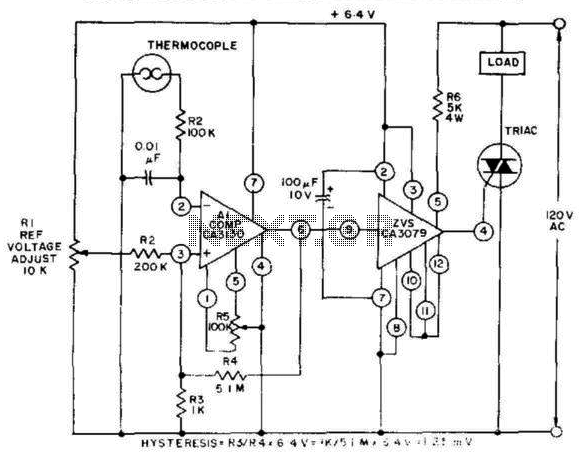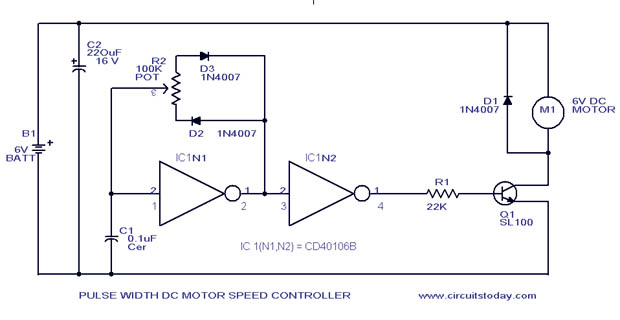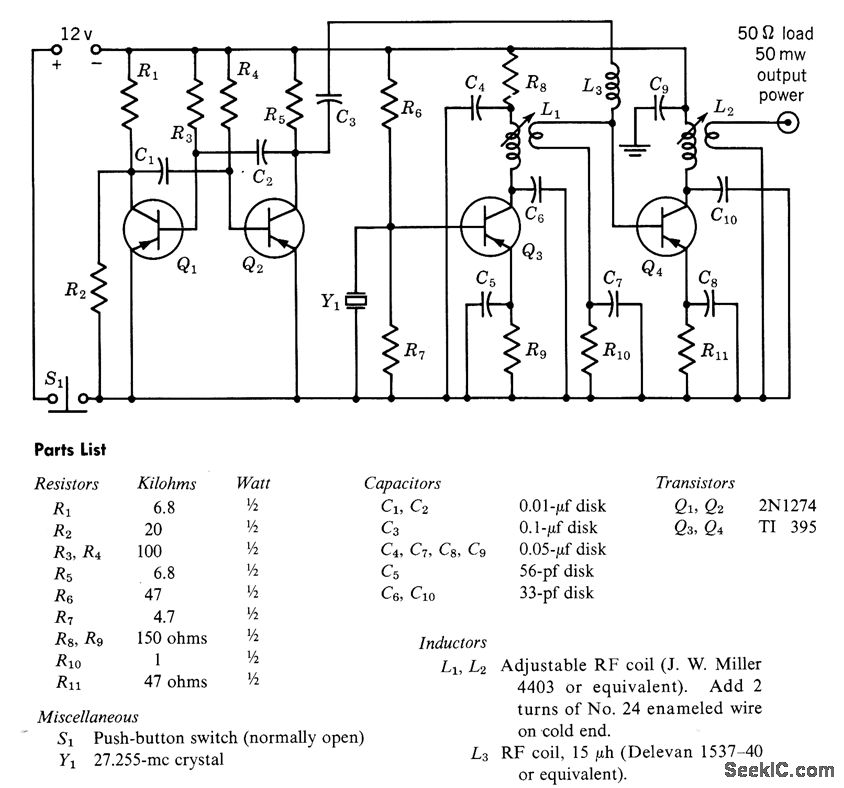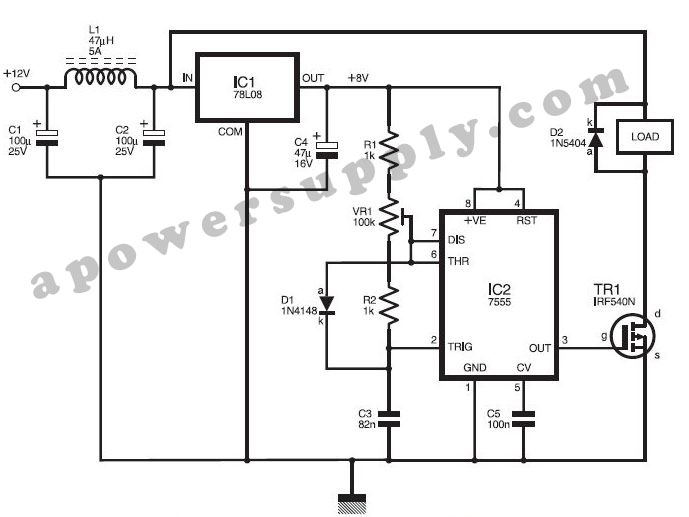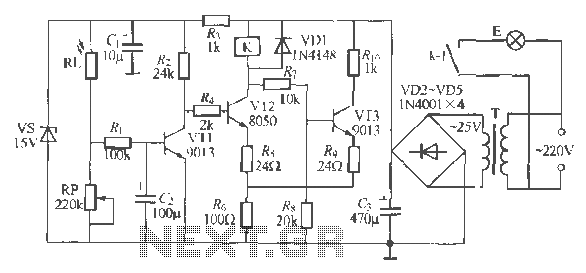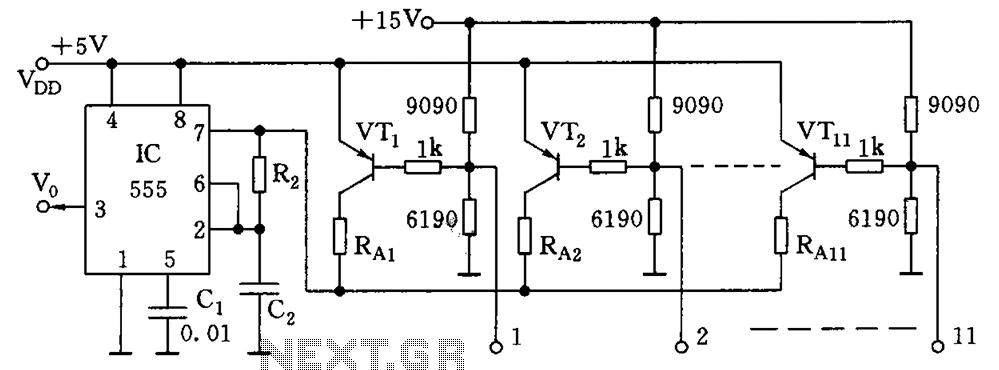
Dc Motor-Speed Control
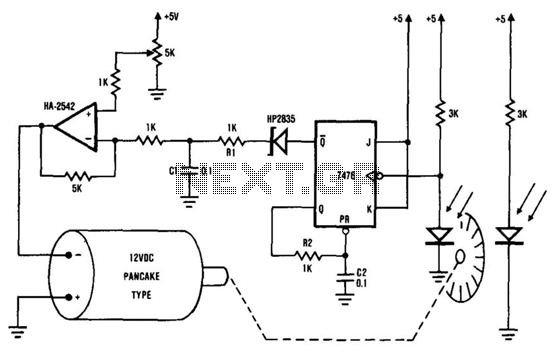
The system comprises the HA-2542 operational amplifier, a compact 12 V DC motor, and a position encoder. During operation, the encoder generates a series of constant-width pulses that charge capacitor C1. These integrated pulses create a reference voltage proportional to the motor speed, which is fed to the inverting input of the HA-2542. The non-inverting input is maintained at a constant voltage representing the desired motor speed. Any difference between these two inputs results in a drive signal correction sent to the motor, thereby completing the speed control loop.
The described system utilizes the HA-2542 operational amplifier as a key component for speed regulation of a 12 V DC motor. The position encoder plays a crucial role by generating constant-width pulses that are integrated to create a reference voltage. This voltage is indicative of the motor's current speed and is essential for feedback control.
The operational amplifier functions in a closed-loop configuration, where the inverting input receives the reference voltage derived from the encoder pulses. The non-inverting input is set to a predetermined voltage that corresponds to the target speed of the motor. The operational amplifier compares these two voltages, and any discrepancy between them is processed to produce an output signal that adjusts the motor's drive voltage.
This feedback mechanism ensures that the motor operates at the desired speed by continuously monitoring its actual speed and making real-time adjustments. The capacitor C1 plays a vital role in smoothing out the pulse signal from the encoder, allowing for a more stable reference voltage. This design is particularly effective in applications requiring precise speed control, such as robotics, conveyor systems, and automated machinery.
The overall system architecture illustrates the integration of electronic components to achieve efficient motor control, highlighting the importance of feedback loops in maintaining desired operational parameters. The system shown consists of the HA-2542, a small 12-Vdc motor, and a position encoder. During operation, the encode r causes a series of "constant-width" pulses to charge CI. The integrated pulses develop a reference voltage, which is proportional to motor speed and is applied to the inverting input of HA-2542. The noninverting input is held at a constant voltage, which represents the desired motor speed. A difference between these two inputs will send a corrected drive signal to the motor, which completes the speed control system loop.
🔗 External reference
The described system utilizes the HA-2542 operational amplifier as a key component for speed regulation of a 12 V DC motor. The position encoder plays a crucial role by generating constant-width pulses that are integrated to create a reference voltage. This voltage is indicative of the motor's current speed and is essential for feedback control.
The operational amplifier functions in a closed-loop configuration, where the inverting input receives the reference voltage derived from the encoder pulses. The non-inverting input is set to a predetermined voltage that corresponds to the target speed of the motor. The operational amplifier compares these two voltages, and any discrepancy between them is processed to produce an output signal that adjusts the motor's drive voltage.
This feedback mechanism ensures that the motor operates at the desired speed by continuously monitoring its actual speed and making real-time adjustments. The capacitor C1 plays a vital role in smoothing out the pulse signal from the encoder, allowing for a more stable reference voltage. This design is particularly effective in applications requiring precise speed control, such as robotics, conveyor systems, and automated machinery.
The overall system architecture illustrates the integration of electronic components to achieve efficient motor control, highlighting the importance of feedback loops in maintaining desired operational parameters. The system shown consists of the HA-2542, a small 12-Vdc motor, and a position encoder. During operation, the encode r causes a series of "constant-width" pulses to charge CI. The integrated pulses develop a reference voltage, which is proportional to motor speed and is applied to the inverting input of HA-2542. The noninverting input is held at a constant voltage, which represents the desired motor speed. A difference between these two inputs will send a corrected drive signal to the motor, which completes the speed control system loop.
🔗 External reference
